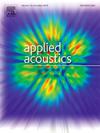Quantitative study on energy distribution and mode conversion of ultrasonic guided waves interacting with stepped and tapered transition regions
IF 3.4
2区 物理与天体物理
Q1 ACOUSTICS
引用次数: 0
Abstract
Ultrasonic guided waves (UGWs) are extensively used in structural health monitoring and nondestructive testing, particularly for complex structures such as lap joints, icing plates, and composite interfaces. This study comprehensively investigates the mode conversion, reflection, and transmission of UGWs both at the stepped and tapered transition region, where geometric discontinuity causes energy redistribution among various modes of reflected and transmitted UGWs. The Frequency Domain Finite Element method is employed to quantitatively analyse the mode energy distribution across a frequency range of 0 ∼ 3 MHz, with Mode S0 as the incident UGW. The results demonstrate that the energy distribution of transmitted UGW modes follows the phase velocity matching principle, whereas the reflected UGW energy exhibits no discernible pattern. Both the linearly and curvedly tapered transition regions improve the energy transmission efficiency by mitigating mode mismatches. Furthermore, increasing the length-to-thickness ratio of linearly tapered transition enhances the energy transmission, reaching over 99% at all frequencies when the ratio exceeds 5. The validation is conducted with the Time Domain Finite Element method and experiment. These findings provide valuable insights for optimizing the selection of UGWs, improving the accuracy and effectiveness of monitoring at stepped and tapered structures.
与阶梯和锥形过渡区相互作用的超声导波的能量分布和模式转换定量研究
超声导波(ugw)广泛应用于结构健康监测和无损检测,特别是对于搭接、覆冰板和复合材料界面等复杂结构。本研究全面研究了阶梯过渡区和锥形过渡区ugw的模式转换、反射和透射,其中几何不连续性导致了反射和透射ugw的各种模式之间的能量重新分布。采用频域有限元方法定量分析了模态能量在0 ~ 3 MHz频率范围内的分布,其中模态S0为入射UGW。结果表明:传输UGW模式的能量分布遵循相速度匹配原则,而反射UGW模式的能量分布则没有明显的规律。线性和曲线锥形过渡区都通过减轻模式不匹配来提高能量传输效率。此外,增加线性锥形过渡的长厚比可以提高能量传输,当长厚比大于5时,在所有频率下能量传输都达到99%以上。通过时域有限元法和实验对该方法进行了验证。这些发现为优化ugw的选择,提高台阶和锥形结构监测的准确性和有效性提供了有价值的见解。
本文章由计算机程序翻译,如有差异,请以英文原文为准。
求助全文
约1分钟内获得全文
求助全文
来源期刊

Applied Acoustics
物理-声学
CiteScore
7.40
自引率
11.80%
发文量
618
审稿时长
7.5 months
期刊介绍:
Since its launch in 1968, Applied Acoustics has been publishing high quality research papers providing state-of-the-art coverage of research findings for engineers and scientists involved in applications of acoustics in the widest sense.
Applied Acoustics looks not only at recent developments in the understanding of acoustics but also at ways of exploiting that understanding. The Journal aims to encourage the exchange of practical experience through publication and in so doing creates a fund of technological information that can be used for solving related problems. The presentation of information in graphical or tabular form is especially encouraged. If a report of a mathematical development is a necessary part of a paper it is important to ensure that it is there only as an integral part of a practical solution to a problem and is supported by data. Applied Acoustics encourages the exchange of practical experience in the following ways: • Complete Papers • Short Technical Notes • Review Articles; and thereby provides a wealth of technological information that can be used to solve related problems.
Manuscripts that address all fields of applications of acoustics ranging from medicine and NDT to the environment and buildings are welcome.
 求助内容:
求助内容: 应助结果提醒方式:
应助结果提醒方式:


